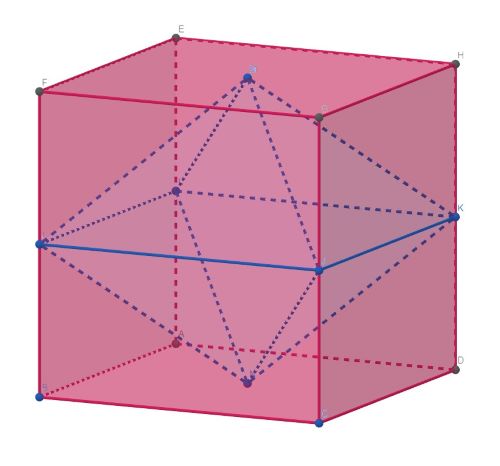In this tutorial we are going to demonstrate one of the possible applications of \((t, m, s)\)-nets, namely, the approximate calculation of body volume. For our educational purposes we are going to consider a three-dimensional octahedron \(\Sigma\) with vertices \((0.5,0.5,0)\), \((0,0,0.5)\), \((1,0,0.5)\), \((1,1,0.5)\), \((0,1,0.5)\), \((0.5,0.5,1)\). You may see \(\Sigma\) inscribed into a three-dimensional unit cube in a figure below.

To estimate the volume of \(\Sigma\) signified hereafter with \(V(\Sigma)\) we may saturate the unit cube with some \((t, m, s)\)-net and use the following formula:
\[V(\Sigma) \approx \frac{|N \cap \Sigma|}{|N|}\]
where \(N\) is the constructed \((t, m, s)\)-net. Speaking in plain English, the approximate value of volume can be found as a ratio of the number of net points that ended up inside of the octahedron to the total number of net points.
1. Basic workflow
Let us assume the same file structure as in the previous tutorial. Thus, we need to open and edit an empty main.cpp file that will contain the code for our desired program.
It is quite natural to state that in order to get an accurate estimation of \(V(\Sigma)\) we need to generate a rather huge net. Let us start, then, with construction of a three-dimensional net with, say, \(2^{20} = 1,048,576\) points.
After that we just need a loop that will traverse all points of our net and count how many of them are inside of \(\Sigma\).
2. Identify points within the octahedron
The only thing missing in our program is the aforementioned function isPointInside that would return true, if the given point is inside of the octahedron, and false, otherwise.
As we may notice, \(\Sigma\) is symmetric about the plane \(z = 0.5\). Knowing this, we may state that there exists a function \(\Delta(x,y)\) such that for any three-dimensional point \(a = (x, y, z)\) it is true that \(a \in \Sigma \Leftrightarrow 0.5 - \Delta(x,y) \le z \le 0.5 + \Delta(x,y)\). \(\Delta(x,y)\) can be expressed in the following way: \(\Delta(x,y) = 0.5 - \max \{|x - 0.5|, |y - 0.5|\}\). Let us now code this in C++.
The expected output is:
To check our answer let us find the precise value of \(V(\Sigma)\) with the help of the formula: \(V(\Sigma) = \frac{1}{3}Sh\) where \(S\) is the square of the base and \(h\) is the distance between two opposing vertices about the base. If we substitue, we get \(V(\Sigma) = \frac{1}{3} \cdot 1 \cdot 1 = \frac{1}{3}\). As we see, our estimation is pretty accurate.